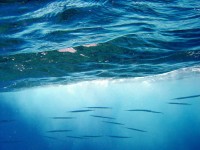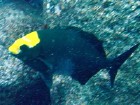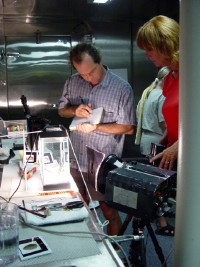September 20th: Gardner Pinnacles
Written By Dan Suthers September 20-21, 2004
 This morning I awoke with Gardner Pinnacles outside my porthole. I went up to the top deck and saw a large rock and a small rock covered with guano surrounded by open ocean. As I view the smallest of the NWHI, I try to imagine its previous form, believed to be an island larger than Lana`i [2]. Not visible to me is a diverse community of 600,000 acres of coral, including at least 27 species [1]. Since data collection is conducted primarily around the small pinnacles, we will be only here for the day, transiting again to Maro Reef tonight.
This morning I awoke with Gardner Pinnacles outside my porthole. I went up to the top deck and saw a large rock and a small rock covered with guano surrounded by open ocean. As I view the smallest of the NWHI, I try to imagine its previous form, believed to be an island larger than Lana`i [2]. Not visible to me is a diverse community of 600,000 acres of coral, including at least 27 species [1]. Since data collection is conducted primarily around the small pinnacles, we will be only here for the day, transiting again to Maro Reef tonight.
Downtown at the Pinnacles
Arrangements were made for the education team to snorkel at the base of the pinnacles where the REA teams were conducting their surveys. There are large blocks of rock providing habitat for fish at different depth, so this is an excellent location to observe and photograph fish as well as the dive operations. We were picked up after lunch, when the Mooring Team was done with its primary work and could make HI-2 available.
The seas were rougher today: periodic sets coming through would raise and then drop the launches about 4-5 feet as we were trying to move gear or people between them and the Hi`ialakai. As we motored out to the pinnacles, waves occasionally crashed over the deck and ourselves.
 We stopped at the base of Gardner Pinnacles nestled in a relatively calmer area between the two pinnacles. This being the only land for hundreds of miles around, it is the animal equivalent of a town in the outback. Three Monk seals rested on a ledge at the base of the small pinnacle, while hundreds of seabirds covered the larger pinnacle or flew around. In the blue waters (strikingly different than yesterday's green water at La Perouse), we saw many interesting fish, an occasional shark, and were often followed by curious ulua, a few almost as large as a person. During our time there, the algae, coral and fish REA teams were conducting transects along the base of the pinnacle.
We stopped at the base of Gardner Pinnacles nestled in a relatively calmer area between the two pinnacles. This being the only land for hundreds of miles around, it is the animal equivalent of a town in the outback. Three Monk seals rested on a ledge at the base of the small pinnacle, while hundreds of seabirds covered the larger pinnacle or flew around. In the blue waters (strikingly different than yesterday's green water at La Perouse), we saw many interesting fish, an occasional shark, and were often followed by curious ulua, a few almost as large as a person. During our time there, the algae, coral and fish REA teams were conducting transects along the base of the pinnacle.
 With the help of Mooring team diver-turned-snorkeler Elizabeth Keenan (who can hold her breath much longer and dive much deeper than I can), we obtained some photographs of the deeper fish and the divers. One of the fish she photographed is shown here: can you identify it? Use the "Ask About It!" link to tell us what you think it is! Watch the bottom of this page for replies.
With the help of Mooring team diver-turned-snorkeler Elizabeth Keenan (who can hold her breath much longer and dive much deeper than I can), we obtained some photographs of the deeper fish and the divers. One of the fish she photographed is shown here: can you identify it? Use the "Ask About It!" link to tell us what you think it is! Watch the bottom of this page for replies.
Not long before we were to leave and as the divers were ascending, three eagle rays, at least as many sharks, and a monk seal showed up and swam around the area as we followed, enthralled and taking pictures. They had been out hunting and returned to find intruders in their evening home.
Planning for Maro
 In the evening, we again sailed towards the NorthWest. Around dinner, a squall came in. We were advised over the intercom to retrieve anything we had drying outside, and I ran to get my wet suit.
In the evening, we again sailed towards the NorthWest. Around dinner, a squall came in. We were advised over the intercom to retrieve anything we had drying outside, and I ran to get my wet suit.
The scientists met after dinner to plan our upcoming operations at Maro Reef. I am told that the water is murky: not great for underwater photography, but an excellent location for finding a diversity of invertebrates. I have asked to observe the mooring team and towbaord operations from their boats so that I can report more accurately to my readers, but this may not happen until the third day. Therefore I hope to have an opportunity to catch up on writing.
After the planning meeting, I went up to the bridge for my daily ritual of recording sunsets at sea. The large squall that had just passed over us was visible off starboard, as well as on the radar screens on the bridge (see photo). The skies were cloudy and squalls could be seen in the distance; not promising for sunset. However, a thin patch of sky was visible just above the horizon: I correctly predicted that the sun would make a brief appearance there. As the now-orange sphere of blinding fusion worked its way leisurely through the gap, rays slipped through to light up various clouds in the otherwise dim atmosphere.
The Lab is Hopping Tonight
In the drylab tonight, there is the usual data processing activity on the benches, and Stephani Holzwarth is patiently sewing up a net to be used to catch samples. I went to the wet lab to investigate the banging noises and occasional bright flashes of light coming out of there.
Jean Kenyon, the coral specialist who I wrote about yesterday, was breaking up, bottling, and labeling coral samples, including Pocillopora meandrina - ("califlower coral") and Montipora capitata ("rice coral"). Both are common in all of the Hawaiian islands. If they are common in the Main Hawaiian Islands, why does she need samples from up here? Jean is gathering many samples from all over the NWHI for DNA analysis to be done by Evelyn Cox at the Hawai`i Institute of Marine Biology. DNA analysis will tell them which populations throughout the Main and NW Hawaiian Islands have similar genetics. Knowing this, we know where to go if we have to regenerate a population that were lost. Also, since coral larvae disperse by ocean currents, it will be interesting to compare these population relationships to ocean current data being gathered by the oceanographers. This work is another example of the collaborative nature of research. Jean is a specialist in field work: the other scientists can rely on her to accurately identify the species and record the locations of samples gathered, and she relies on them to do DNA analysis and to study ocean currents. I am impressed that at least two major studies rely on her daily field work: people like her are valuable resources for science.
 That explains the noise, but what about the light? David Liittschwager and Susan Middleton are photographing a Turbo sandwicensis (Hawaiian Turban shell). They have been waiting for it to open its "cat's eye" (operculum) and venture out of its shell. It is a slow process: they wait up to half an hour for it to open, but when they take a photograph, the flash scares the animal, which promptly slams it's operculum shut again. So, another half an hour wait to get the next photograph. One photograph is not enough: one of the strategies used by creative people is to generate many examples, then compare them and choose the best. (I take over a hundred photographs a day for this web site.)
That explains the noise, but what about the light? David Liittschwager and Susan Middleton are photographing a Turbo sandwicensis (Hawaiian Turban shell). They have been waiting for it to open its "cat's eye" (operculum) and venture out of its shell. It is a slow process: they wait up to half an hour for it to open, but when they take a photograph, the flash scares the animal, which promptly slams it's operculum shut again. So, another half an hour wait to get the next photograph. One photograph is not enough: one of the strategies used by creative people is to generate many examples, then compare them and choose the best. (I take over a hundred photographs a day for this web site.)
That's all for now; I am settling in for a few hours of writing and image processing.
[1] NOAA (2003)
[2] Rauzon (2001)
 Talk About It!
Talk About It!
Identifying the Yellow Headed Mystery Fish, Part 2!
Asked by John on Oct 30, 2004.
The dark fish with the yellow head looks like the nenue "traditionally" known as Kyphosus bigibbus but which now has a new scientific name. See: http://www.hawaiisfishes.com/fish_of_month/past_fom/fom_05_04.htm
The photo is awfully small--how about posting a larger photo?
Answered by Randy Kosaki (NOAA CRER) and Dan Suthers (U. Hawaii) on Nov 18, 2004.
Randy Kosaki replies:
The fish in question is most likely K. sandwicensis (until very recently, known as K. bigibbus). For more than you'd really care to know about the taxonomy of Pacific kyphosids, see:
Sakai, K., and T. Nakabo. 2004. Two new species of Kyphosus (Kyphosidae) and a taxonomic review of Kyphosus bigibbus Lacepede from the Indo-Pacific. Ichthyological Research 51(1):103-108.
Dan Suthers adds:
The web page John referenced is also informative - thanks! The photos were small because these web pages were originally uploaded via satellite phone from the Hi`ialakai. My communications bill for the trip was over $2400. But now that I'm home I'll put in a link from the small image to a larger version.
Identifying the Yellow Headed Mystery Fish
Asked by Blake on Nov 2, 2004.
The fish in question looks like the gray rudderfish Kyphosus bigibbus in the middle of its xanthic color change from gray to yellow or the other way around. Could also be Kyphosus vaigiensis.
Answered by Dan Suthers from the University of Hawaii on Nov 18, 2004.
Blake, thanks for your reply. You are right about the Color change and genus, but it turns out that species identification of this fish is more subtle than I thought when I posted the question! See John's answer, and the reply to him from Randy Kosaki.
Golden Nenue
Asked by Jordan from Kamehameha Schools on Aug 17, 2005.
It is a golden nenue. They were thought to be the queen of the species because only some were turned gold for no reason at all. They are very rare. You were lucky to see one.
Answered by Dan Suthers, University of Hawaii on Aug 19, 2005.
Yes, it is. As an informal observation I am finding that most large schools of nenue have a golden one! Presently I am on the "Boatload of Educators" voyage (August 2005), and we have frequently encountered schools with one golden nenue, but never two, as far as I can recall. This makes me wonder why ...
Next Journal